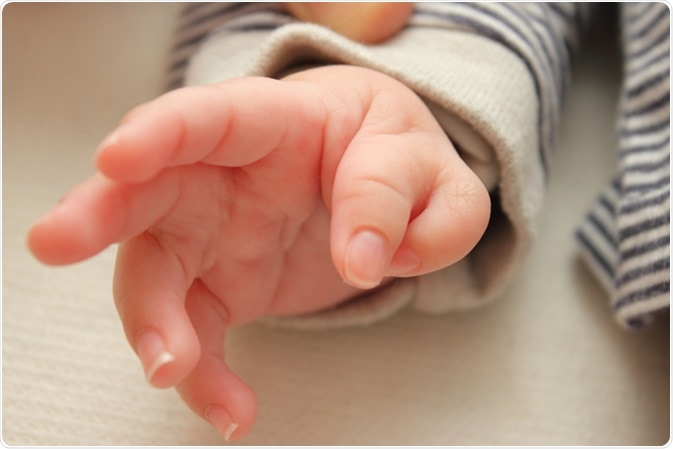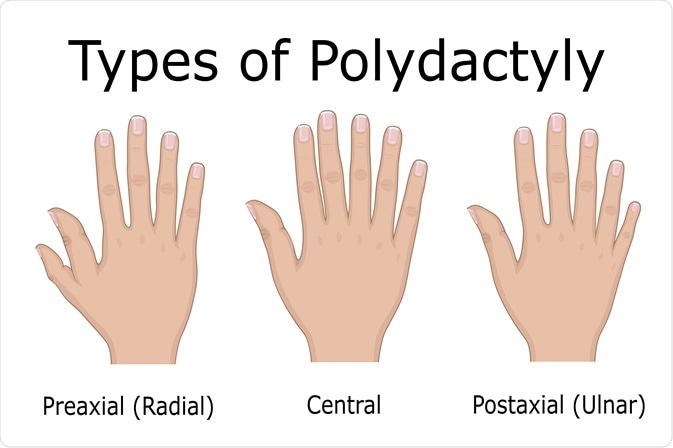Polydactyly is a condition in which a child has additional fingers or toes. It is quite common and most often, the extra digit is smaller than the usual fingers or toes.
At times, the additional digit may not be well-formed and is just a nubbin connected to the fingers or toes by a thin tissue stalk. In other cases, it is a well-formed digits with normal bone, blood vessels, muscles, and nerves. In the latter case, the digits are firmly connected to the foot or hand.
 Polydactyly" />
Polydactyly" />
Polydactyly, Congenital. Image Credit: v.gi / Shutterstock
Epidemiology of polydactyly
One in 500 to 1,000 infants in the USA are affected by polydactyly. This incidence is 1 in 1,339 newborns among the Caucasian race has polydactyly. Among the African and African-American races, 1 in 143 newborns has some form of polydactyly. In Caucasians and Asians, polydactyly is mostly seen on the side of the thumb, whereas in African-Americans, polydactyly is seen on the side of the little finger or toe.
Studies have found that when all types of polydactyly are put together, the incidence in black men and women is 13.5 per 1000 and 11.1 per 1000, respectively, and among caucasian men and women is 2.3 per 1000 and 0.6 per 1000, respectively.
During 2002, there were only eight newborns with polydactyly reported in the UK. When both parents were polydactyls, there was a 75% probability of polydactyly in the offspring. Heredity contributes to 15% of polydactyly causation.
The family with six fingers - Countdown To Life: The Extraordinary Making Of You: Episode 1 - BBC
Preaxial polydactyly
There are three types of polydactyly based on the position of the additional digit. They are:
- Preaxial polydactyly
- Postaxial polydactyly
- Central polydactyly
In preaxial polydactyly, the additional digit is present on the outside of the big toe or thumb. When present in the feet, the presence of the extra digit is known as tibial polydactyly. When present in the hand, it is known as radial polydactyly.
Based on the Wassel classification, preaxial polydactyly is further classified into seven types:
- Bifid distal phalanx
- Duplicated distal phalanx
- Bifid proximal phalanx
- Duplicated proximal phalanx
- Bifid metacarpal
- Duplicated metacarpal
- Triphalangia
Preaxial polydactyly occurs in 1 in 1,000 to 10,000 newborns. Type IV or duplicated proximal phalanx is the most common form, and occurs in 43%. It may be connected with syndromes such as tibial defects, Fanconi's anemia, imperforate anus, Holt-Oram syndrome, Blackfan-Diamond anemia, and cleft palate. Type II or duplicated distal phalanx is in the second position and occurs in 15% of the population.
Males are more affected than females. Conditions such as pollux abductus are associated with preaxial polydactyly.
 Illustration of three types of polydactyly. Image Credit: Scio21 / Shutterstock.com
Illustration of three types of polydactyly. Image Credit: Scio21 / Shutterstock.com
Postaxial polydactyly
In postaxial polydactyly, the additional digit is present on the outside of the little toe or little finger. When present in the feet, the presence of the extra digit is known as fibular polydactyly. When present in the hand, it is known as ulnar polydactyly.
When the digits are well formed, it is categorized as Type A. The presence of vestigial digits characterizes Type B polydactyly. Postaxial polydactyly is seen 10 times more often among African-Americans and occurs in 1 in 3,000 infants. Inheritance mostly follows an autosomal dominant pattern.
Various studies have reported the incidence of polydactyly among embryos and newborns, across different human races and the two genders.
In Japan, the frequency of polydactyly is higher in embryos that are spontaneously aborted compared with newborns. About 0.35% of polydactyly of all types put together was found in 36 380 induced abortion embryos. Among the 129 embryos that were affected, postaxial polydactyly was seen in 29 embryos (12 versus 17 in the fingers and toes respectively).
In Seattle, out of 5200 abortions, polydactyly was visible in 20 embryos. Of these, 67.9% had postaxial polydactyly. Bilateral polydactyly was observed in 33% and other abnormalities were associated in 30%.
Among newborns, polydactyly cases are the lowest among the Japanese (0.08/1000), while South Africans and African-Americans in the USA were reported to have 1%.
| Race/origin |
Isolated type A category |
Isolated type B category |
Type A & B |
Type B only |
Type unspecified |
|
Caucasians
|
0.25/1,000
|
0.91/1,000
|
|
|
|
|
African Americans
|
0.16/1,000
|
12.4/1,000
|
0.12/1,000
|
|
|
|
American Indians
|
|
|
1.07/1,000
|
0.73/1,000
|
|
|
Africans in South Africa
|
|
|
|
|
10.04/1,000
|
In unilateral polydactyly, the left foot or the left hand is the most often affected. In one particular study of 762 newborns with unilateral polydactyly, the left hand was affected in 77%. The same study found that out of 56% of newborns with postaxial polydactyly in the foot, the left foot was affected. Left-side polydactyly was noticed in 10 of 11 affected newborns. Compared with unilateral polydactyly, bilateral forms are more common.
Central polydactyly, where the additional digit is present between the toes or fingers, is a rare form of polydactyly.
References
Further Reading